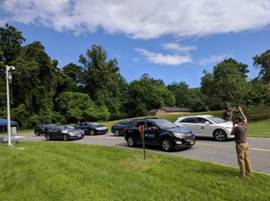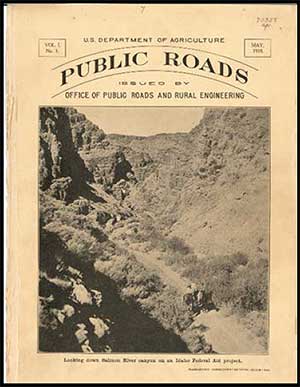U.S. Department of Transportation
Federal Highway Administration
1200 New Jersey Avenue, SE
Washington, DC 20590
202-366-4000
Federal Highway Administration Research and Technology
Coordinating, Developing, and Delivering Highway Transportation Innovations
|
R&T NOW This newsletter is an archived publication and may contain dated technical, contact, and link information. |
|
| Publication Number: Date: July/August 2018 |
Publication Date: July/August 2018
|
PDF files can be viewed with the Acrobat® Reader®
Turner-Fairbank Leads the Way with Connected Vehicles
The Federal Highway Administration’s (FHWA’s) Turner-Fairbank Highway Research Center (TFHRC) in McLean, VA, successfully hosted a connected vehicle pilot program in partnership with the United States Department of Transportation’s (USDOT’s) Intelligent Transportation Systems Joint Program Office (ITS JPO) during the week of June 25, 2018. More than 100 test runs, 75 supporting participants, and 7 different vendors who provided equipment resulted in the largest and most successful interoperability testing of connected vehicle equipment to date, and demonstrated how quickly Dedicated Short-Range Communication (DSRC) equipment is advancing towards widescale commercial deployment.
The goal of the program was to observe and analyze how well connected vehicle devices from various manufacturers operated and interacted with each other. Another goal was to analyze site configuration and the infrastructure needed to support connected vehicles. “The results of the tests will ensure that our infrastructure from Virginia to California is interoperable,” said Brian Cronin, Director of the Office of Operations Research and Development.

Source: USDOT ITS JPO
Connected vehicles drive through the connected infrastructure on TFHRC’s roads.
FHWA’s Saxton Transportation Operations Laboratory, operated by Leidos, provided vehicles, drivers, technical support, and a connected infrastructure for the safe testing of equipment and applications. This is part of the Saxton Laboratory’s Connected and Automated Vehicle (CAV) Support Services, funded by FHWA and the ITS JPO to advance the deployment of new technologies by private industry and support operators in their adoption.
Noblis and Leidos organized the event for the Connected Vehicle Pilot sites in New York City, Tampa, and Wyoming, and they organized the companies that provided equipment and applications – Brandmotion, Commsignia, Danlaw, Lear, Savari, Siemens, and SiriusXM.
Now that testing is complete, researchers will analyze the data and, if necessary, steps will be taken to improve the devices and software configuration.

Source: USDOT ITS JPO
A researcher signals to drivers of connected vehicles to proceed onto TFHRC’s connected roads and infrastructure.
The testing has already shown great promise. One participant noted that this was the first time in history that showed multiple devices working with the security credential management system (SCMS).
The SCMS is a message security solution for vehicle-to-vehicle and vehicle-to-infrastructure communication.

Source: USDOT ITS JPO
Tony English from the Wyoming DOT reviews data during the connected vehicle pilot program.
Connected vehicles use DSRC radios to transmit and receive information with other vehicles and infrastructure. Infrastructure communications use a roadside unit (RSU) that includes a DSRC radio to communicate with vehicles. Additional communication protocols communicate with traffic signal controllers, transportation management centers, and other infrastructure equipment. Information transmitted through RSUs to the connected vehicle include lane geometries, traveler advisory messages, and real-time traffic signal phase and timing. RSUs also receive the basic safety message that does not personally identify vehicles, but includes valuable information on vehicle speed and trajectory that can enable operators to improve transportation operations.
For more information, contact Deborah Curtis, 202–493–3267, Deborah.Curtis@dot.gov.
EAR Program Developments Provide Tools to Improve Safety
Extracting and analyzing safety-related information from large datasets related to driver behavior, vehicle performance, traffic patterns, weather, and infrastructure characteristics could help reduce vehicle crashes. The Federal Highway Administration (FHWA) Exploratory Advanced Research (EAR) Program is supporting two research projects on processing massive amounts of transportation-related data from structured, semistructured, and unstructured datasets using open-source tools and technology.
The Palo Alto Research Center, Inc. (PARC) is developing automated methods to integrate information from large unrelated datasets. PARC researchers are using video, radar, and still photography gathered at Chicago intersections. The researchers will be refining tools developed through the PARC project for use with similar data-rich information resources.
CUBRC, a Buffalo, New York-based systems integration research organization, is developing a layered infrastructure to ingest, store, analyze, and display information. Application of the CUBRC-designed Transportation Research Informatics Platform (TRIP) may make massive amounts of transportation-related data accessible for knowledge discovery and to analyze the data to reveal patterns related to traffic safety. At CUBRC, researchers developed TRIP in two layers. The first layer involves the platform itself on a LINUX operating system foundation. The second layer integrates open-source tools to ingest, transform, align, and store structured and unstructured data. CUBRC is testing TRIP with sample datasets from the Seattle, Washington, region.
A fact sheet containing additional information regarding the two projects will be available online at http://www.fhwa.dot.gov/advancedresearch/pubs.cfm.
For more information about the PARC project, contact Ana Eigen at 202–493–3168, ana.eigen@dot.gov. For more information about the CUBRC project, contact James Pol at 202–493–3371, james.pol@dot.gov. For more information about the EAR Program, contact David Kuehn, 202–493–3414, david.kuehn@dot.gov.
FHWA and Caltrans Host U.S.–Japan Bridge Engineering Workshop
The Federal Highway Administration (FHWA) and the California Department of Transportation (Caltrans) hosted the U.S.–Japan Bridge Engineering Workshop in Los Angeles, CA, on July 16–18, 2018. The workshop was conducted in cooperation with the National Institute of Land, Infrastructure and Management (NILIM) of Japan. Additional support in planning and execution was provided by the Oregon Department of Transportation and the Washington State Department of Transportation. The workshop was attended by State DOTs––including California, Oregon, Washington, Alaska, Florida, Iowa, and Michigan––academia, and private sector firms from the United States, and government officials and academia from Japan.
The 2018 workshop was conducted under the provisions of an October 2017 Memorandum of Understanding between the United States Department of Transportation and Japan’s Ministry of Land, Infrastructure, Transport, and Tourism, and under the auspices of the U.S.–Japan Cooperative Program in Natural Resources (UJNR) Task Committee G – Transportation Systems.
The workshop is a continuation of a series of technical exchanges, first held in 1984, between the United States and Japan on topics related to bridge engineering. These workshops have focused on seismic design, protection measures, innovative materials, bridge preservation, and durability issues. The two countries have also collaborated on research, personnel exchange, and on reconnaissance after major earthquakes.
Both countries have realized significant benefits.The exchanges have proven to be an effective way of advancing bridge technology and best practices in both countries.
As in the past, this workshop was convened to provide a forum bringing together bridge engineers from the United States and Japan to exchange promising ideas and technologies, and share critical knowledge and lessons learned through observations and practice to further bridge engineering.
Focus this year was on “Decision Making, Institutional Layout, Use of Specifications and Guidelines” to improve understanding on the governance of transportation policy, and standards and guidance for designing and preserving bridges; “Bridge Designed for Enhanced Durability” to improve our understanding of strategies and practices; “Bridge Instrumentation and Health Monitoring” to learn about the practicality of the technology and extent of its use and challenges; “Guidelines and Use of Refined Numerical Calculations for Design and Bridge Assessment; and “Innovative Materials for Bridge Design and Construction” on usage of high-performance materials and best applications for the new materials.
For more information, contact Sheila Duwadi, 202–493–3106, sheila.duwadi@dot.gov.
Federal Highway Administration Announces $2 Million for Emergency Repairs to Flood-Damaged Roads and Bridges in Michigan
The Federal Highway Administration announced on July 3, 2018, the immediate availability of $2 million in Emergency Relief (ER) program funds to help begin repairs on flood-damaged roads and bridges in Michigan.
“The Upper Peninsula of Michigan experienced considerable damage to roads and bridges as the result of heavy rainfall and flooding that these quick release funds will help address,” said Acting Federal Highway Administrator Brandye L. Hendrickson. “The funding represents the first installment of funds to the State to ensure all necessary repairs are completed as quickly as possible.”
On June 17, 2018, heavy rainfall caused flooding in Gogebic, Houghton, and Menominee counties in the western Upper Peninsula of Michigan. Areas of the affected counties received as much as 7 to 10 inches of rain in few hours, which caused extreme runoff and flooding. Significant damage to State and local Federal-aid routes resulted, including several bridge and culvert washouts.
The $2 million in “quick release” funding will be used to restore essential traffic for local communities.
This initial “quick release” payment is considered a down payment on the costs of short-term repairs while the State continues damage assessments for long-term repairs. The FHWA’s ER program provides funding for highways and bridges damaged by natural disasters or catastrophic events.
For more information, contact Nancy Singer, 202–366–0660, nancy.singer@dot.gov.
FHWA to Analyze How Cyclical and Seasonal Influences Affect Highway Crash Data
The Federal Highway Administration (FHWA) and the United States Census Bureau will conduct a Time Series’ Seasonal Adjustment (SA) analysis beginning October 2018. The SA analysis is the result of a June 2018 agreement between FHWA and the Census Bureau. The analysis will attempt to eliminate cyclical and seasonal influences related to highway crashes using the Census Bureau’s SA software. The analysis will support the development of reliable crash models for better estimations and predictions of priority safety concerns, and it will attempt to identify causes of crash upsurges.
A time series is a series of data points listed in order of time that the data points occurred. Time series analysis uses statistical methods for analyzing time series data to develop models for forecasting future values based on previously observed data values. Seasonal adjustment is a statistical method for removing the seasonal component (i.e. weekly, monthly, or quarterly) that has a seasonal pattern.
The seasonal adjustment method is used to analyze the trend of a time series independently of the seasonal components. Highway crashes are a time series and have seasonal fluctuations. Seasonal adjustment methods can remove the crash data seasonal effect to better determine the major causes behind the priority crash concerns.
The analysis will allow FHWA to achieve short- and long-term safety goals. Over the short term, FHWA will be able to determine effective low-cost safety countermeasures, and over the long term, FHWA will be able to identify major crash factors to advance highway design and operation and develop effective highway safety policies.
For more information, contact Roya Amjadi, 202–493–3383, roya.amjadi@dot.gov.
Public Roads Reaches Centennial Milestone
FHWA’s premiere journal, Public Roads magazine, celebrated its 100th anniversary in May 2018. Volume 1, Number 1 of Public Roads was printed in May 1918 by the Office of Public Roads and Engineering, a unit of the U.S. Department of Agriculture. For the last 100 years, Public Roads magazine has documented the expansion of the Nation’s road systems and the research conducted to improve them. For the next century, Public Roads will continue to feature the latest developments in Federal Highway policies, programs, and research and technology. A special 100th anniversary edition of Public Roads is online now, and special events are planned to celebrate the Public Roads centennial.

Source: FHWA
The first issue of Public Roads, May 1918.

Source: FHWA
Summer 2018 edition of Public Roads, 100 years later.
Public Roads—Summer 2018
This issue includes: Improving Work Zones Every Day, in Every Way; Transportation Safety in Tribal Areas; A New View for Bridge Inspectors; Bigger is Not Always Better; Inspiring Successive Generations; A Journey to Better Highways: 100 Years
It is available online via https://www.fhwa.dot.gov/publications/publicroads/18summer/18summer/index.html.
For more information, contact Lisa Shuler, lisa.a.shuler@dot.gov.
Innovator: Accelerating Innovation for the American Driving Experience—July/August 2018
This issue includes: Building Bridges Better; Making Connections with Ultra-High Performance Concrete; Synchronizing Environmental and Permitting Reviews to Accelerate Project Delivery; Pavement Preservation; Ambassadors of Innovation; Transportation Innovation Officers Explore Common Ground; States Innovate!
The issue is available online via https://www.fhwa.dot.gov/innovation/innovator/issue67/3dIssue/.
Turner-Fairbank Highway Research Center: www.fhwa.dot.gov/research/tfhrc/
Resource Center: www.fhwa.dot.gov/resourcecenter/
National Highway Institute: www.nhi.fhwa.dot.gov/home.aspx
Please forward this newsletter to others you think might find it interesting and/or useful.
Suggestions may be submitted to: FHWA_Now@fhwa.dot.gov.